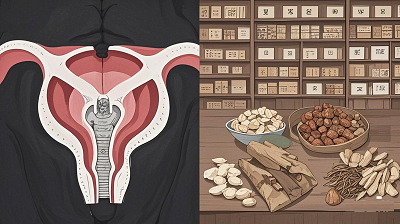Chronic Prostatitis Treatment: Pelvic Floor Therapy vs. Traditional Chinese Medicine
Chronic prostatitis is a common male urological condition, affecting approximately 10-15% of men worldwide at some point in their lives. Typical symptoms include perineal or lower abdominal pain, frequent and urgent urination, increased nighttime urination, difficulty urinating, and even sexual dysfunction. Due to its complex causes, conventional treatments such as antibiotics and α-blockers often have limited effectiveness, leaving many patients struggling with recurring symptoms.

In recent years, pelvic floor therapy has gained attention as a physical treatment, while Traditional Chinese Medicine (TCM) has been increasingly recognized for its holistic approach. So, which of these two methods is more effective for treating chronic prostatitis?
Pelvic Floor Therapy: Mechanism and Limitations
Pelvic floor therapy utilizes physical techniques such as biofeedback training, electrical stimulation, manual massage, and Kegel exercises to relax or strengthen the pelvic floor muscles, thereby alleviating pain and urinary symptoms. The underlying theory is that some cases of chronic prostatitis may result from pelvic floor muscle tension or dysfunction rather than a simple bacterial infection.
Advantages of Pelvic Floor Therapy:
Relieves prostatitis-related pain caused by muscle tension, especially for non-bacterial prostatitis.
Non-invasive treatment with no drug-related side effects.
Strengthens pelvic floor muscles, improving urinary control.
Suitable for patients whose pelvic floor muscle tension is caused by prolonged sitting, high stress levels, or sports injuries.
Limitations of Pelvic Floor Therapy:
Not all cases of chronic prostatitis are caused by muscle issues. If the root cause involves chronic inflammation, immune dysfunction, or poor prostatic microcirculation, pelvic floor therapy offers limited benefits.
Requires long-term commitment; noticeable improvements usually take months.
Can be expensive and requires professional equipment and guidance, making it difficult to practice independently.
Does not directly eliminate inflammation within the prostate or repair damaged tissue, failing to address the root cause.
The Holistic Advantages of Traditional Chinese Medicine
Unlike pelvic floor therapy, TCM takes a holistic approach, viewing chronic prostatitis as a condition related to damp-heat accumulation and blood stagnation. Therefore, the key to treatment lies in clearing heat, promoting blood circulation, improving local prostate circulation, and enhancing the immune system.
We recommend Diuretic and Anti-inflammatory Pill, a TCM-based formula developed to clear heat, detoxify, promote blood circulation, and relieve urinary difficulties. This formula helps address chronic prostatitis from its root.
Advantages of Traditional Chinese Medicine:
Broader Treatment Scope: Suitable for both muscle-tension prostatitis and bacterial/non-bacterial prostatitis, especially for patients with persistent and recurrent symptoms.
Anti-inflammatory and Restorative Effects: Clears heat and toxins, reduces inflammation, and promotes tissue repair.
Improves Microcirculation: Enhances blood flow, alleviates prostatic duct blockages, and helps discharge inflammatory secretions.
Holistic Health Benefits: Not only relieves prostate symptoms but also improves overall circulation, reduces damp-heat accumulation, and strengthens immunity to prevent recurrence.
No Dependency or Severe Side Effects: Made from pure herbal ingredients, avoiding the resistance or side effects associated with antibiotics or hormonal treatments.
Convenient Use: No need for special equipment or long-term training—simply take it at home.
Long-Term Effectiveness: Unlike pelvic floor therapy, which requires ongoing training, TCM provides relief within a shorter period and reduces the chances of relapse.
Case Studies
Many patients have tried Western medications and physical therapy but still struggle with chronic prostatitis.
Justin, 35 years old, developed chronic prostatitis due to prolonged sitting and work-related stress. Initially, he tried pelvic floor exercises but found the results inconsistent. Later, he switched to Diuretic and Anti-inflammatory Pill, and after three months, his symptoms significantly improved, with no further recurrence.
Ashish, 42 years old, experienced painful urination, urinary urgency, and perineal discomfort. Despite trying antibiotics and physiotherapy, his symptoms kept returning. After two months on Diuretic and Anti-inflammatory Pill, his urination normalized, pain subsided, and his quality of life improved.
Which Treatment is Best for You?
Pelvic floor therapy is beneficial for prostatitis caused by muscle tension, but it does not directly address inflammation or improve prostate microcirculation. In contrast, TCM focuses on regulating the body holistically, reducing inflammation, and improving local circulation to provide lasting relief. For most chronic prostatitis patients, especially those with prolonged and complex symptoms, TCM is the more comprehensive and effective choice.
Conclusion
The treatment of chronic prostatitis should be tailored to the individual. While pelvic floor therapy may help certain patients, it has significant limitations. TCM, with its holistic regulation, anti-inflammatory effects, and long-term benefits, stands out as a superior option.
If you're looking for a safe, effective, and long-term solution for chronic prostatitis, Diuretic and Anti-inflammatory Pill is a trustworthy choice.
You may also be interested in:
Herbal Solutions for Chronic Prostatitis: A Natural Approach to Healing
Chronic Prostatitis Physical Therapy: Effective Strategies for Relief and Recovery



